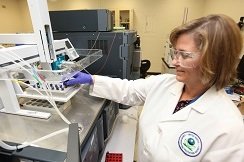

Disclaimer: Any mention of trade names, manufacturers, or products does not imply an endorsement by EPA. EPA and its employees do not endorse commercial products, services, or enterprises.
Per- and polyfluoroalkyl substances (PFAS) are a large class of synthetic chemicals that present numerous analytical challenges, including their widespread presence in a variety of environmental samples, occurrence of isomers for some compounds, and precursor transformations that may occur during preservation and storage of the samples. EPA’s methods for analyzing PFAS in environmental media are in various stages of development and validation.
EPA scientists are developing validated analytical methods for drinking water; groundwater; surface water; wastewater; and solids, including soils, sediments, biota, and biosolids, which may eventually become standard methods or research methods. Visit EPA's status of PFAS research and development webpage to get updates about this and other PFAS research.
For more information about EPA PFAS research, please visit EPA's webpage on PFAS Research and Development.
Understanding Targeted vs. Non-Targeted AnalysisStandard methods are methods that have been through a laboratory validation process following a particular rulemaking or guidance effort and are available to support regulatory or guidance activities.
EPA method for measuring 18 PFAS in drinking water, including HFPO-DA (one component of the GenX processing aid technology).
Note: Method 537.1 was updated in 2020 to version 2.0. The only updates were editorial and did not include any technical revisions.
EPA method for measuring 14 PFAS in drinking water.
Note: This is referenced for historical purposes only. Method 537 was updated in 2018 to Method 537.1 (above).
EPA method for measuring 40 PFAS in wastewater, surface water, groundwater, soil, biosolids, sediment, landfill leachate, and fish tissue.
EPA and the Department of Defense collaborated on the development of this method.
A method for measuring 50 PFAS in air emissions from stationary sources. This method focuses on semivolatile and particulate-bound PFAS.
EPA intends for the scientific community to provide feedback on OTM-45. Scientists and stakeholders can learn more about the process for submitting feedback in the introduction text of the method document.
A method for measuring 30 PFAS in air emissions from stationary sources. This method focuses on certain volatile PFAS.
EPA intends for the scientific community to provide feedback on OTM-50. Scientists and stakeholders can learn more about the process for submitting feedback in the introduction text of the method document.
The following Standard Operating Procedures (SOPs) were used to conduct the the research described in the associated publications. The SOPs listed are not official EPA methods and have not been validated. They were reviewed and approved internally by EPA to meet data quality objectives associated with specific research projects. EPA made these SOPs available as a reference for anyone interested in pursuing additional research, and/or modifying or implementing some of the procedures.
This section is still in development and will be coming soon.
Other U.S. federal agencies have developed and published methods; more information is available on those agencies’ sites.
The following resources can be used as a starting point for identifying sampling protocols for PFAS in environmental media:
Other laboratories provide access to obtain standards and reference materials.